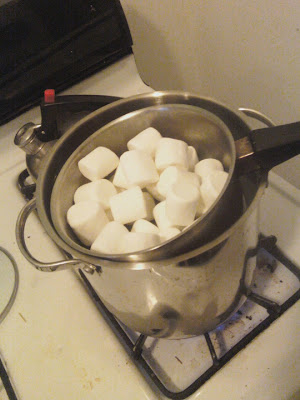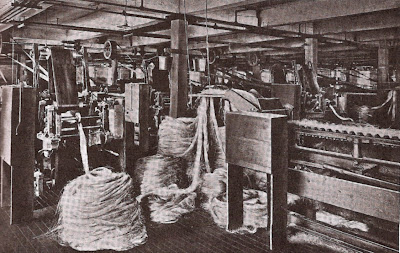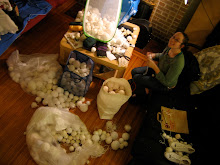January: Time Travel Pie
(aka Creme de Menthe Pie)
In honor of the beginning of the last season of LOST, I present pie from a bygone era. Creme de Menthe makes me think of 1950's holiday cocktail parties and a time when it was totally acceptable to make an entire desert out of other, pre-packaged desserts. The alcohol content, albeit more symbolic than anything else, evokes a bit of a desperate housewife image. Also, it's green. YES! And although the time tumbling cast of LOST only spent a hot second in the 50's... hell, why not! (Thanks to Brece for the recipe!)
16-18 chocolate oreo cookies, (my aunt used 24 for a 10" pie plate)
1/3 c. melted oleo
26 large marshmallows
1/2 c. milk
1/4 c. green creme de menthe
1 c. whipping cream, whipped and unsweetened (believe me you do not need any more sugar!)
2 squares chocolate
Crush cookies to fine crumbs (blender). add melted oleo and mix well. shape into pie pan and chill. mix marshmallows and milk in top of double boiler. stir over low heat until marshmallows have melted. cool to room temperature. add creme de menthe. fold into whipped heavy cream. spoon into pie shell and chill. garnish with grated chocolate and remaining additional heavy cream and/or fresh mint leaves.
(*Oleo?? Clearly I didn't use Oleo. I used Earth Balance. Which is like Oleo but fully endorsed by the Whole Foods Generation. Seemed to work just fine as a replacement.)

Apparently Lee owns a blender! (Which would have come in really handy that time I tried to make a ginger-snap crust a few months ago and ended up making the most pathetic mortar and pestle out of a titanium thermos and a metal bowl. Not even kidding. It wasn't pretty. Or quiet.) The blender crushed those oreos with ease, though, so the crust was completed without insult or injury.

Who doesn't love a good double boiler? It took a while to heat up (mostly because the only other pot i own is a huge soup pot...) but the marshmallows melted quickly and evenly once the water was finally boiling.

Oh man... adding the Creme de Menthe was like adding alcoholic food coloring! I have no idea what kind of drinks you'd make with Creme de Menthe... but that stuff is STRONG! (The color, that is, not the alcohol...) I imagine you have to mix it with a bunch of stuff to dilute it enough to be safe for drinking.
I topped the pie, fittingly enough, with shavings from an individually pre-packaged, mini hershey's chocolate bar after letting the pie chill for several hours in the fridge. And, when served, it was delicious. No seriously. DELICIOUS! I mean, how could it NOT be when it's main ingredients are Oreos, marshmallows, alcohol and sugar?? But, astoundingly, the pie was even better than the sum of the delicious delicious parts. LOST club gave it a unanimous A+ rating, with some members risking missing important scenes to serve themselves seconds! I HIGHLY recommend this recipe to anyone who enjoys the mint/chocolate combination and wooing their friends.
Success!
(*Oleo?? Clearly I didn't use Oleo. I used Earth Balance. Which is like Oleo but fully endorsed by the Whole Foods Generation. Seemed to work just fine as a replacement.)

Apparently Lee owns a blender! (Which would have come in really handy that time I tried to make a ginger-snap crust a few months ago and ended up making the most pathetic mortar and pestle out of a titanium thermos and a metal bowl. Not even kidding. It wasn't pretty. Or quiet.) The blender crushed those oreos with ease, though, so the crust was completed without insult or injury.

Who doesn't love a good double boiler? It took a while to heat up (mostly because the only other pot i own is a huge soup pot...) but the marshmallows melted quickly and evenly once the water was finally boiling.

Oh man... adding the Creme de Menthe was like adding alcoholic food coloring! I have no idea what kind of drinks you'd make with Creme de Menthe... but that stuff is STRONG! (The color, that is, not the alcohol...) I imagine you have to mix it with a bunch of stuff to dilute it enough to be safe for drinking.
I topped the pie, fittingly enough, with shavings from an individually pre-packaged, mini hershey's chocolate bar after letting the pie chill for several hours in the fridge. And, when served, it was delicious. No seriously. DELICIOUS! I mean, how could it NOT be when it's main ingredients are Oreos, marshmallows, alcohol and sugar?? But, astoundingly, the pie was even better than the sum of the delicious delicious parts. LOST club gave it a unanimous A+ rating, with some members risking missing important scenes to serve themselves seconds! I HIGHLY recommend this recipe to anyone who enjoys the mint/chocolate combination and wooing their friends.
Success!















